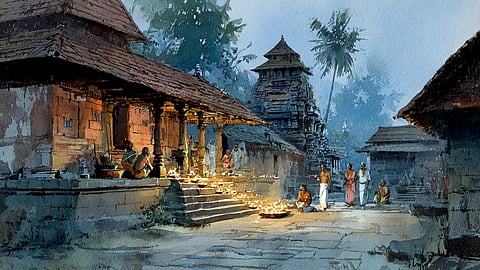- Commentary
- History Vignettes
- Notes on Culture
- Dispatches
- Podcasts
- Indian LanguagesIndian Languages
- Support

WE CAN BEGIN the survey of the Hindu legal system right from the top: i.e., punishment of corrupt government officials. In general, their wealth was confiscated and the official was banished or jailed.
We notice this exact mode of punishment in the reign of Rajaraja Chola. In 1234 CE, the village assembly of Rajasundari Chaturvedimangalam dismissed a village accountant who had defrauded the villagers. It didn’t stop at that. It banned all his descendants from holding any government job for four generations. His property was seized and auctioned back to the village.
For our next example, we’ll visit the neighbour of the Cholas: Kerala. Here, we see scores of examples in which the royal family itself was punished, and we can mention only two incidents.
1. In 1102 CE, the Chera king Kulashekhara-Chakravartin was once summoned to trial by the town council, which met in Panaingavu Palace at Kollam. He had been found guilty of causelessly murdering some Ariyars or Archakas in the Rameshwara Temple. The verdict: the king had to make a substantial land grant to the temple and had to undergo rigourous penance to atone for his crime.
2. In 1344 CE, Vira Keralavarman of Tiruvadi was found guilty of murdering some Brahmanas and other temple officials. The verdict: he was ordered to pay land compensation to the immediate kin of the victims. He also had to make substantial donations to a specified temple.
3. In 1382 CE, Vira Martandavarman atoned for certain atrocities he had committed against various people, by giving the gift of silver pots and cash fines to the temple.
The inscriptions that narrate these incidents say that these penalties were called garvakkattu or amercement for high-handed conduct. The guilty kings were forced to pay these fines in order to bring the offender to justice no matter how powerful he or she was. And who awarded these punishments? It was the local assemblies which wielded enormous power in those days.
What is even more noteworthy is that the kings accepted these punishments. This stemmed from the timeless Sanatana dictum that the power of the king derives from the popular consent of the people and that there were solid restraints to check his power.
As we’ve seen in many essays on The Dharma Dispatch, we have hundreds of more such examples spread throughout Bharatavarsha over at least two millennia but I’ll give one more example before closing this section.
Sometime in the 12th or 13th Century, a Rajput King was ordered to atone for some crime by donating a huge sum of money to a Devi temple and also by digging a stepwell for the benefit of Yatris travelling to Pushkar or other sacred sites in Rajasthan.
What is also remarkable is the fact that in most of these cases — apart from penalties — Prayaschitta was an inevitable component of every punishment. Indeed, prayaschitta forms one of the central pillars of the Hindu legal and justice system. The Dharmasastra annals contain copious meanings of the word Prayaschitta suppplemented by exhaustive discursions upon it. A rather evocative description is worth quoting here:
… 'prayascitta' means such actions as tapas, gifts and sacrifices whereby a man becomes purified (prayata) and destroys his accumulated sins ('cita' being equal to 'upacita'), just as clothes are made clean by the employment of salts, moist heat, putting in boiling water on a fire, and washing in water.
The corpus of non-Dharmasastra literature are similarly replete with hundreds of stories and real-life examples of the value of prayaschitta as a form of punishment, as a guiding ideal of life and as a soul-purifying agent. In the examples I have just quoted, it is significant that these judgements were engraved on the walls of the respective temples.
One reason for this could be a conscious and time-honoured custom of trying to reduce the tendencies of extreme vengeance on the part of the victim’s survivors. Simultaneously, it was meant to induce the feeling of remorse within the criminal by putting him in front of the Devatas, who are the true judges of human actions. If a criminal is made to light lamps in a temple every evening for say 48 days, what feeling will emanate within him?
The vision of Hindu lawgivers was to mitigate ill-will within the society as far as possible through a determined pursuit of spirituality. Conscious forgiveness on the part of the survivor and conscious expiation on the part of the perpetrator are two sides of the same coin.
Indeed, there is abundant food for thought when we think about it in a different light: violent prosecution of a criminal as opposed to ordering the criminal to light lamps in a temple everyday without fail. Reform and self-purification.
Our ancient Rishis were Rishis for a reason.
To be continued
If you liked this article, please consider making a contribution of your choice to The Dharma Dispatch so we can offer you more such informative and insightful content on a range of topics related to Indian history, civilisation and culture.
The Dharma Dispatch is a work of devotion and piety. We offer it to our readership out of a profound sense of duty.
Your financial support helps us keep our content free. To support our sacred work, click the button below.
The Dharma Dispatch is now available on Telegram! For original and insightful narratives on Indian Culture and History, subscribe to us on Telegram.
